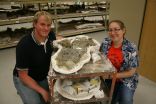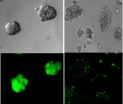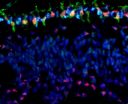Brain scans reveal 'gray matter' differences in media multitaskers
2014-09-24
(Press-News.org) Simultaneously using mobile phones, laptops and other media devices could be changing the structure of our brains, according to new University of Sussex research.
A study published today (24 September) reveals that people who frequently use several media devices at the same time have lower grey-matter density in one particular region of the brain compared to those who use just one device occasionally.
The research supports earlier studies showing connections between high media-multitasking activity and poor attention in the face of distractions, along with emotional problems such as depression and anxiety.
But neuroscientists Kep kee Loh and Dr Ryota Kanai point out that their study reveals a link rather than causality and that a long-term study needs to be carried out to understand whether high concurrent media usage leads to changes in the brain structure, or whether those with less-dense grey matter are more attracted to media multitasking.
The researchers at the University of Sussex's Sackler Centre for Consciousness used functional magnetic resonance imaging (fMRI) to look at the brain structures of 75 adults, who had all answered a questionnaire regarding their use and consumption of media devices, including mobile phones and computers, as well as television and print media.
They found that, independent of individual personality traits, people who used a higher number of media devices concurrently also had smaller grey matter density in the part of the brain known as the anterior cingulate cortex (ACC), the region notably responsible for cognitive and emotional control functions.
Kep kee Loh says: "Media multitasking is becoming more prevalent in our lives today and there is increasing concern about its impacts on our cognition and social-emotional well-being. Our study was the first to reveal links between media multitasking and brain structure."
Scientists have previously demonstrated that brain structure can be altered upon prolonged exposure to novel environments and experience. The neural pathways and synapses can change based on our behaviours, environment, emotions, and can happen at the cellular level (in the case of learning and memory) or cortical re-mapping, which is how specific functions of a damaged brain region could be re-mapped to a remaining intact region.
Other studies have shown that training (such as learning to juggle, or taxi drivers learning the map of London) can increase grey-matter densities in certain parts of the brain.
"The exact mechanisms of these changes are still unclear," says Kep kee Loh. "Although it is conceivable that individuals with small ACC are more susceptible to multitasking situations due to weaker ability in cognitive control or socio-emotional regulation, it is equally plausible that higher levels of exposure to multitasking situations leads to structural changes in the ACC. A longitudinal study is required to unambiguously determine the direction of causation." INFORMATION:
Notes for editors
'High media multi-tasking is associated with smaller gray-matter density in the anterior cingulate cortex' by Kep Kee Loh and Dr Ryota Kanai is published in Plos One on 24 September 2014
Press Office: press@sussex.ac.uk Tel: 01273 678888
ELSE PRESS RELEASES FROM THIS DATE:
Colorado's Front Range fire severity not much different than past, say CU study
2014-09-24
The perception that Colorado's Front Range wildfires are becoming increasingly severe does not hold much water scientifically, according to a massive new study led by the University of Colorado Boulder and Humboldt State University in Arcata, Calif.
The study authors, who looked at 1.3 million acres of ponderosa pine and mixed conifer forest from Teller County west of Colorado Springs through Larimer County west and north of Fort Collins, reconstructed the timing and severity of past fires using fire-scarred trees and tree-ring data going back to the 1600s. Only 16 percent ...
New dinosaur from New Mexico has relatives in Alberta
2014-09-24
(Edmonton) A newly discovered armoured dinosaur from New Mexico has close ties to the dinosaurs of Alberta, say University of Alberta paleontologists involved in the research.
From 76 to 66 million years ago, Alberta was home to at least five species of ankylosaurid dinosaurs, the group that includes club-tailed giants like Ankylosaurus. But fewer ankylosaurids are known from the southern parts of North America. The new species, Ziapelta sanjuanensis, was discovered in 2011 in the Bisti/De-na-zin Wilderness area of New Mexico by a team from the New Mexico Museum of Natural ...
A way to kill chemo-resistant ovarian cancer cells: Cut down its protector
2014-09-24
Ottawa, Canada – September 24, 2014 – Ovarian cancer is the most deadly gynecological cancer, claiming the lives of more than 50% of women who are diagnosed with the disease. A study involving Ottawa and Taiwan researchers, published today in the influential Proceedings of the National Academy of Sciences (PNAS), provides new insight into why ovarian cancer is often resistant to chemotherapy, as well as a potential way to improve its diagnosis and treatment.
It is estimated that 2,700 Canadian women will be diagnosed with ovarian cancer in 2014 and that 1,750 Canadian ...
Star Trekish, rafting scientists make bold discovery on Fraser River
2014-09-24
A Simon Fraser University-led team behind a new discovery has "…had the vision to go, like Star Trek, where no one has gone before: to a steep and violent bedrock canyon, with surprising results."
That comment comes from a reviewer about a truly groundbreaking study just published in the journal Nature.
Scientists studying river flow in bedrock canyons for the first time have discovered that previous conceptions of flow and incision in bedrock-rivers are wrong.
SFU geography professor Jeremy Venditti led the team of SFU, University of Ottawa and University of British ...
Bacterial 'communication system' could be used to stop and kill cancer cells, MU study finds
2014-09-24
COLUMBIA, Mo. – Cancer, while always dangerous, truly becomes life-threatening when cancer cells begin to spread to different areas throughout the body. Now, researchers at the University of Missouri have discovered that a molecule used as a communication system by bacteria can be manipulated to prevent cancer cells from spreading. Senthil Kumar, an assistant research professor and assistant director of the Comparative Oncology and Epigenetics Laboratory at the MU College of Veterinary Medicine, says this communication system can be used to "tell" cancer cells how to act, ...
Study: Biochar alters water flow to improve sand and clay
2014-09-24
As more gardeners and farmers add ground charcoal, or biochar, to soil to both boost crop yields and counter global climate change, a new study by researchers at Rice University and Colorado College could help settle the debate about one of biochar's biggest benefits -- the seemingly contradictory ability to make clay soils drain faster and sandy soils drain slower.
The study, available online this week in the journal PLOS ONE, offers the first detailed explanation for the hydrological mystery.
"Understanding the controls on water movement through biochar-amended soils ...
NASA sees the end of post-depression Fung-Wong
2014-09-24
Tropical Depression Fung-Wong looked more like a cold front on infrared satellite imagery from NASA than it did a low pressure area with a circulation.
NASA's Aqua satellite passed over Tropical Depression Fung-Wong on Sept. 23 at 12:23 a.m. EDT. The Atmospheric Infrared Sounder or AIRS instrument that flies aboard Aqua gathered infrared temperature data on the storm's clouds. The data was false-colored at NASA's Jet Propulsion Laboratory, Pasadena, California and showed that the storm resembled a frontal system more than a depression. The center of circulation was southwest ...
How a single, genetic change causes retinal tumors in young children
2014-09-24
Retinoblastoma is a childhood retinal tumor usually affecting children one to two years of age. Although rare, it is the most common malignant tumor of the eye in children. Left untreated, retinoblastoma can be fatal or result in blindness. It has also played a special role in understanding cancer, because retinoblastomas have been found to develop in response to the mutation of a single gene – the RB1 gene—demonstrating that some cells are only a step away from developing into a life-threatening malignancy.
David E. Cobrinik, MD, PhD, of The Vision Center at Children's ...
New milestone in the search for water on distant planets
2014-09-24
Astronomers have found water vapor in the atmosphere of a planet about four times bigger than Earth, in the constellation Cygnus about 124 light years - or nearly 729 trillion miles - from our home planet. In the quest to learn about planets beyond our solar system, this discovery marks the smallest planet for which scientists have been able to identify some chemical components of its atmosphere.
The researchers' findings were published Sept. 25, 2014 in the journal Nature. The team was led by University of Maryland Astronomy Professor Drake Deming, an expert in the study ...
A single statistic can strengthen public support for traffic safety laws
2014-09-24
Public support for effective road safety laws, already solid, can be strengthened by a single number: a statistic that quantifies the traffic-related injury risks associated with a given law, according to a new study from the Johns Hopkins Center for Injury Research and Policy at the Johns Hopkins Bloomberg School of Public Health.
The study, published in the September issue of Accident Analysis & Prevention, surveyed 2,397 adults nationwide about their attitudes toward four types of road-safety laws —mandatory ignition interlock installation for people convicted of driving ...





